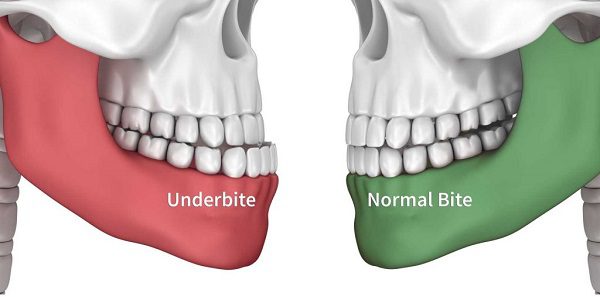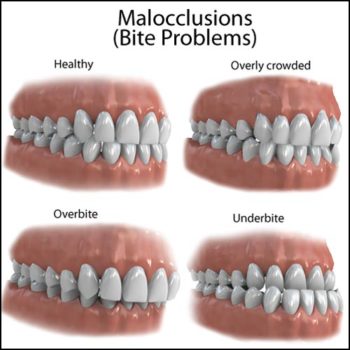Overbite vs Normal Teeth Bite
Your teeth are misaligned. The problem is not just in your mouth, but also down on the other end of it. Bad bites happen when upper and lower jaws don’t line up properly for a nice smile-perfection shape that fits together like puzzle pieces should be clicking into place.
Chances are, you’ve heard of overbites and underbites. But did you know that there are actually several kinds? Four to be exact: an excessive amount when it comes in terms of width (overbite); not enough room between your teeth for eating cleanly(underbite). Then we have cross-bite which can cause alignment issues as well because one side may dominate throughout life depending on how much they slope towards another angle – this would show up most often during smiling selfies. Then the Open bite could occur in the front or in the back of the mouth, although a frontal open bite is much more common.

FOUR DIFFERENT KINDS OF BITES
Overbite
Have you ever wondered why some people have an overbite and others don’t? The answer is that every person’s mouth doesn’t fit like a puzzle. Some might be misaligned, which can lead to distinctive symptoms such as your top teeth biting down on your lower gums or protruding past the bottom ones in what looks more than just “misalignment.”
Overbite is a condition in which your teeth are too far forward on one side of the mouth, causing tension and discomfort. If left untreated it can result in headaches due to increased pressure from chewing food or even uneven wear on enamel.
Underbite
If you have an underbite, then your lower teeth may be protruding past the top ones. This is caused by an extended jaw or pushed-in face resulting from excessive thumb-sucking as well as tongue thrusting during childhood years that could not only affect how others see us now but also what they think of themselves because everyone expects their mouth to match up correctly. An underbite can cause jaw stress and chewing challenges just like overbites. You might even experience sleep apnea or difficulty enunciating certain words or sounds.

Crossbite
There are many reasons why you might develop a crossbite, including if your baby teeth never came out during childhood or an adult tooth had issues getting ready to pop up. In these cases, your jaw and other teeth respond by developing this condition too. A simple treatment can help relieve the pain caused by excessive pressure on either side of their mouth so make sure that any orthodontic treatments will fix things quickly.
Open bite
Open bites can be either left or right, and they occur when one extends farther than the other. A normal upper tooth will sometimes lightly overlap with its corresponding bottom counterpart while resting; however, an open bite occurs when no contact is made at all during this time period – making it look like there’s only space between them instead of both being covered by individual overlaps as would happen in a correctly positioned teeth arrangement. Some signs of an open bite include:
- A lisp
- Difficulty chewing or swallowing
- Your tongue sits in a different position
- Your teeth are showing irregular wear
OTHER KINDS OF MISALIGNED TEETH
Crooked teeth
Crooked teeth can be the result of bad bite alignment, which is when your upper and lower jaws don’t line up properly. This results in an improper position for both dentist visits as well as oral hygiene habits like brushing too hard or missing some areas with flossing because they are out-of-sight (but definitely not out!).
The most common cause that brings on crookedness? You might think it’s genetics—everyone has their own unique dental structure anyway–though there certainly isn’t one way to get these issues fixed.
Although our teeth naturally move to fill gaps left by teeth that have fallen out, sometimes they don’t shift into a straight position. This can be caused either because of poor nutrition in childhood or adulthood and crooked smiles may seem permanent but there are ways you could get them fixed. The consequences of crooked teeth can be seen as early as infancy. Thumbsucking and tongue thrusting during childhood will push out your top front tooth, while mouth breathing causes lower jaw development which leads to an improper positioning for adult aesthetics such that it’s difficult not only speaking but also eating certain foods.
Crowded Teeth
You might have thought that the smaller your jaw is compared to the size of its teeth, there would be plenty of room for brushing and flossing in all those nooks. But you’d be surprised by how many people experience crowded mouths. This causes problems with oral hygiene because it becomes hard—even impossible to clean between each other’s teeth effectively when they’re too close together; this leads inevitably either to tooth decay or gum disease.
The need for dental work has increased over the years, and people are always looking to change their smiles in some way. Teeth whitening is another common procedure that many choose as an alternative or addition if they have already gone through braces with good results but want even more confidence when smiling at others.
Gap Teeth
Gap teeth sometimes happen when your jaw is larger than the size your teeth need, or conversely when your teeth are smaller or some are missing. If you’re missing your lateral incisors — the teeth on either side of your two top front teeth — this can cause gapping between teeth and it’s something that Dr. Buddy can treat easily at his Simpsonville and Greer offices. Missing lateral incisors is genetic and happens to about 2% of people.
WHAT ARE OTHER SYMPTOMS OF A BAD BITE?
Now that we’ve covered what a bad bite looks like, what are signs you might feel or experience when you have dental malocclusion?
TMJ discomfort
The temporomandibular joint (TMJ) hinges your lower jaw to your skull. It gives your jaw the ability to move for things like speaking, yawning, and chewing. If you have a bad bite, your TMJ might not properly align, resulting in some pain when you open and close your jaw. You might also experience some stiffness, soreness, or hear a clicking noise.
Teeth grinding and clenching your jaw
Do you grind your teeth at night? Or during the daytime? Grinding your teeth — or clenching your jaw — is a sign that your teeth might be misaligned, which puts stress on your jaw. In turn, the stress can lead to headaches and jaw pain. Over time, teeth grinding can also wear down the enamel on your teeth and you might experience more tooth sensitivity or be more prone to tooth decay.
Headaches
Most of us get headaches at one point or another. But if it seems like you get headaches a lot and you’ve ruled out other causes — like stress, computer use, or diet — your headaches could be the result of a bad bite. A misaligned jaw can cause tension on facial joints like your TMJ as well as put strain on the tissue and ligaments around your jaw.
The trouble with speaking
Another way you can tell if you have a bad bite versus a normal bite is if you have difficulty pronouncing sounds or enunciating clearly. Misaligned teeth can show up in a lisp. Or sometimes a smaller jaw doesn’t allow room for your tongue to move freely and it takes extra effort to form words correctly.
Facial Asymmetry
When you look in the mirror, does your face seem asymmetrical? If so, it might be because of a bad bite. Proper bite alignment and straight teeth help define the length and shape of your face, the symmetry of the left and right sides, and the structure of your jawbone.
Frequently Asked Questions (FAQs)
How much overbite is normal?
According to Kevin Walker, DDS, an overbite occurs when the top teeth overlap the bottom teeth by 10% to 20%. This is considered normal and desirable. Walker claims that there is cause for concern if your bite goes beyond this typical overbite range and prevents any contact between your upper and lower teeth.
How can I tell if I have an overbite?
Simply smile while lightly biting down on the mirror to check if you have an overbite. If you can only see 50% or less of your lower front teeth when your jaw is fully closed, you may have an overbite and should consult an orthodontist to confirm.
Are overbite teeth attractive?
Despite the fact that overbites and underbites are both generally seen as undesirable characteristics, both can be fixed with braces, MTM clear aligners, or oral surgery. To establish which choice is best for you, your dentist will take an X-ray.
Is a slight overbite normal?
It's important to keep in mind that having a slight overbite is normal because of how the human skull is shaped, which naturally permits the upper teeth to stick out further than the lower teeth. Your dentist should assess your overbite and underbite during checkups and notify you if they have any concerns.




